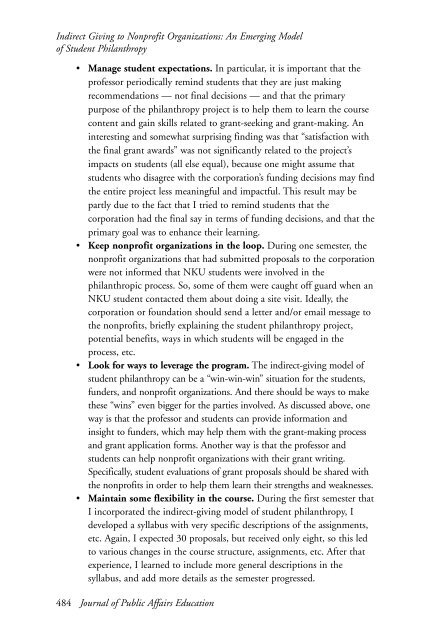JOURNAL OF PUBLIC AFFAIRS EDUCATION - National ...
JOURNAL OF PUBLIC AFFAIRS EDUCATION - National ...
JOURNAL OF PUBLIC AFFAIRS EDUCATION - National ...
You also want an ePaper? Increase the reach of your titles
YUMPU automatically turns print PDFs into web optimized ePapers that Google loves.
Indirect Giving to Nonprofit Organizations: An Emerging Model<br />
of Student Philanthropy<br />
• Manage student expectations. In particular, it is important that the<br />
professor periodically remind students that they are just making<br />
recommendations — not final decisions — and that the primary<br />
purpose of the philanthropy project is to help them to learn the course<br />
content and gain skills related to grant-seeking and grant-making. An<br />
interesting and somewhat surprising finding was that “satisfaction with<br />
the final grant awards” was not significantly related to the project’s<br />
impacts on students (all else equal), because one might assume that<br />
students who disagree with the corporation’s funding decisions may find<br />
the entire project less meaningful and impactful. This result may be<br />
partly due to the fact that I tried to remind students that the<br />
corporation had the final say in terms of funding decisions, and that the<br />
primary goal was to enhance their learning.<br />
• Keep nonprofit organizations in the loop. During one semester, the<br />
nonprofit organizations that had submitted proposals to the corporation<br />
were not informed that NKU students were involved in the<br />
philanthropic process. So, some of them were caught off guard when an<br />
NKU student contacted them about doing a site visit. Ideally, the<br />
corporation or foundation should send a letter and/or email message to<br />
the nonprofits, briefly explaining the student philanthropy project,<br />
potential benefits, ways in which students will be engaged in the<br />
process, etc.<br />
• Look for ways to leverage the program. The indirect-giving model of<br />
student philanthropy can be a “win-win-win” situation for the students,<br />
funders, and nonprofit organizations. And there should be ways to make<br />
these “wins” even bigger for the parties involved. As discussed above, one<br />
way is that the professor and students can provide information and<br />
insight to funders, which may help them with the grant-making process<br />
and grant application forms. Another way is that the professor and<br />
students can help nonprofit organizations with their grant writing.<br />
Specifically, student evaluations of grant proposals should be shared with<br />
the nonprofits in order to help them learn their strengths and weaknesses.<br />
• Maintain some flexibility in the course. During the first semester that<br />
I incorporated the indirect-giving model of student philanthropy, I<br />
developed a syllabus with very specific descriptions of the assignments,<br />
etc. Again, I expected 30 proposals, but received only eight, so this led<br />
to various changes in the course structure, assignments, etc. After that<br />
experience, I learned to include more general descriptions in the<br />
syllabus, and add more details as the semester progressed.<br />
484 Journal of Public Affairs Education

















